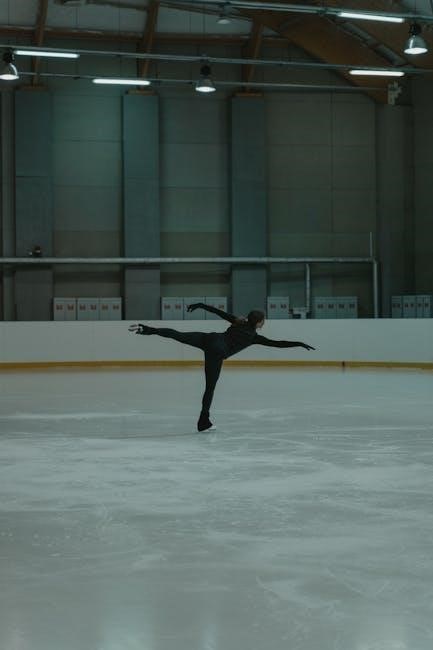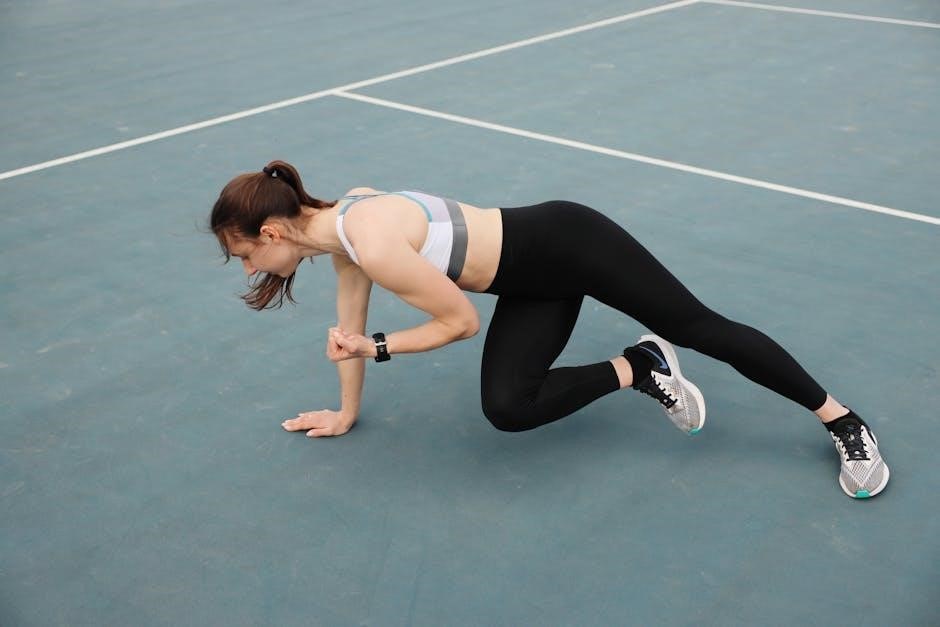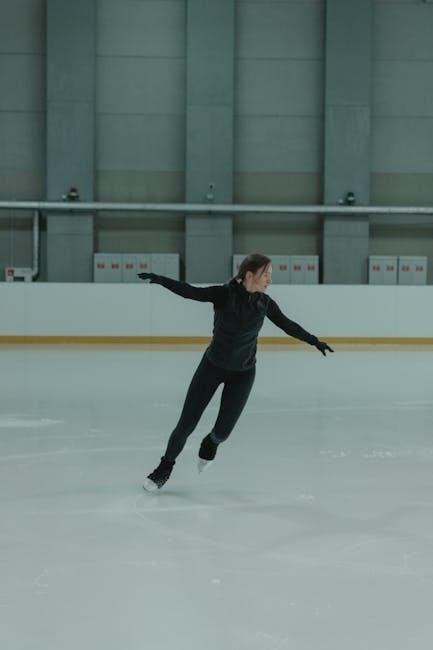Welcome to the introduction to Vastus Medialis exercises, essential for knee stability and strength. Discover how these exercises enhance athletic performance and reduce injury risk through structured PDF guides.
What is the Vastus Medialis Muscle?
The Vastus Medialis muscle is part of the quadriceps group, located on the inner aspect of the thigh. It plays a crucial role in knee extension and stabilization, making it essential for movement and balance. As the innermost of the four quadriceps muscles, it helps track the patella (kneecap) during flexion and extension. Weakness in this muscle can lead to poor knee mechanics, pain, and increased injury risk. Strengthening the Vastus Medialis is often a focus in rehabilitation programs to restore proper knee function and overall lower limb stability.
Importance of Strengthening the Vastus Medialis
Strengthening the Vastus Medialis is vital for maintaining proper knee function and preventing injuries. Weakness in this muscle can lead to poor patellar tracking, increasing the risk of conditions like chondromalacia patella or patellofemoral pain syndrome. A strong Vastus Medialis enhances knee stability, reduces pain, and improves overall athletic performance. It also plays a key role in rehabilitation after knee injuries or surgeries, helping restore normal movement patterns and reducing the likelihood of future issues. Incorporating targeted exercises ensures optimal knee health and functionality in both daily activities and sports.

Anatomy and Function of the Vastus Medialis
The Vastus Medialis is a key quadriceps muscle located on the inner thigh, crucial for knee extension and stability. It ensures proper patellar alignment and movement.
Location and Structure of the Vastus Medialis
The Vastus Medialis is situated on the medial (inner) aspect of the thigh, forming part of the quadriceps muscle group. It originates from the femur’s medial line and inserts into the patella. Structurally, it consists of two parts: the Vastus Medialis Oblique (VMO), which is more prominent and plays a key role in knee stability, and the Vastus Medialis Longus. Together, they work to straighten the knee and provide medial pull, essential for proper patellar tracking and overall lower limb alignment.
Role in Knee Stability and Movement
The Vastus Medialis plays a critical role in knee stability by controlling patellar tracking, ensuring the kneecap moves smoothly in its groove. During movements like walking, running, or climbing stairs, it stabilizes the knee and prevents excessive lateral (outer) movement. Weakness in this muscle can lead to poor knee alignment, resulting in pain and instability. The Vastus Medialis Oblique (VMO) is particularly vital for maintaining proper knee mechanics, especially during weight-bearing activities, making it essential for both everyday mobility and athletic performance.

Benefits of Vastus Medialis Exercises
Strengthening the Vastus Medialis enhances knee stability, reduces pain, and prevents injuries. It improves patellar tracking, boosts athletic performance, and supports overall lower limb function effectively.
Improving Knee Stability and Reducing Pain
Strengthening the vastus medialis is crucial for improving knee stability and reducing pain. Weakness in this muscle often leads to poor knee movement patterns, causing discomfort and strain on the inner knee. Targeted exercises, such as isometric contractions and wall squats, help activate the vastus medialis, enhancing patellar tracking and reducing pain. Regular practice improves joint alignment, lowers the risk of cartilage wear, and restores functional movement. By addressing muscle imbalances, these exercises promote long-term knee health and alleviate chronic pain, making daily activities and sports participation more comfortable and sustainable.
Preventing Injuries and Enhancing Athletic Performance
Strengthening the vastus medialis is vital for preventing injuries and enhancing athletic performance. Weakness in this muscle can lead to poor knee mechanics, increasing the risk of injuries like patellar tendinitis or ligament strains. Exercises targeting the vastus medialis, such as single-leg inner range quadriceps and resistance band workouts, improve muscle balance and patellar tracking. This enhanced stability and strength enable athletes to perform explosive movements, like jumping or sprinting, with greater efficiency and control. By incorporating these exercises, individuals can reduce injury risks and achieve peak performance in sports and physical activities.

Key Exercises for Vastus Medialis Strengthening
Focus on exercises like isometric contractions, wall squats, and single-leg inner range quadriceps to effectively target the vastus medialis. These workouts improve knee stability and strength, reducing pain.
Beginner Exercises: Isometric Contractions and Wall Squats
Start with isometric contractions by sitting with legs extended, contracting the vastus medialis without moving the knee. Hold for 5 seconds, repeating 10-15 times. This strengthens the muscle without stress.
Wall squats involve standing with a ball between knees and wall. Slowly slide down, focusing on vastus medialis activation. This improves patellar tracking and builds foundational strength.
Intermediate Exercises: Single-Leg Inner Range Quadriceps
For single-leg inner range quadriceps, stand on one leg with a resistance band around the other just above the knee. Slowly straighten the leg against the band’s resistance, focusing on vastus medialis activation.
- Start with slight knee bend, band taut.
- Extend leg fully, holding 2-3 seconds;
- Return slowly to starting position.
This exercise enhances strength, stability, and control, crucial for advanced knee rehabilitation and athletic performance. Perform 3 sets of 10-12 repetitions on each leg.
Advanced Exercises: Resistance Band and Dynamic Movements
For advanced resistance band exercises, loop the band around a stable object and attach it to your ankle. Perform dynamic movements like leg extensions, lunges, and lateral steps to engage the vastus medialis.
- Start with controlled leg extensions against the band.
- Incorporate multi-planar movements to simulate real-life actions.
- Focus on slow, deliberate movements to maximize muscle activation.
These exercises improve balance, strength, and functional mobility, ideal for athletes or individuals seeking advanced knee rehabilitation. Aim for 3 sets of 12-15 repetitions per exercise.
Incorporating Vastus Medialis Exercises into Your Workout Routine
Begin with basic exercises like isometric contractions and progress to dynamic movements. Include resistance bands for added resistance and focus on controlled movements to enhance strength and stability.
Creating a Balanced Rehabilitation Program
A well-rounded rehabilitation program focuses on gradual progression, combining strengthening and flexibility exercises. Start with isometric contractions and wall squats, then incorporate resistance bands and dynamic movements. Include rest days to prevent overtraining and ensure proper recovery. Monitor progress and adjust exercises based on feedback and goals. A balanced approach ensures sustained improvement in knee stability and overall muscle function, reducing the risk of future injuries. Use PDF guides for structured routines and track improvements systematically.
Progressing from Basic to Advanced Exercises
Progressing from basic to advanced vastus medialis exercises involves mastering foundational movements before increasing intensity. Begin with isometric contractions and wall squats to build initial strength and control. As comfort and strength improve, introduce resistance bands or weights to challenge the muscle further. Advanced exercises, such as single-leg inner range quadriceps and dynamic movements, target functional strength and stability. Always prioritize proper form and gradual progression to avoid injury. Use PDF guides to track your advancement and ensure a smooth transition between exercise levels, optimizing knee stability and overall performance.

Resources for Vastus Medialis Exercises
Discover comprehensive vastus medialis exercises in PDF formats through mobile apps and e-books. Access customizable workout plans and join online forums for shared resources and expert tips today.
PDF Guides and Printable Workout Plans
Enhance your fitness journey with detailed vastus medialis exercises PDF guides. These resources offer structured routines, including step-by-step instructions and illustrations for optimal muscle engagement. Printable workout plans allow easy tracking of progress, ensuring consistency and motivation. Whether you’re a beginner or advanced, these guides provide customizable options to suit your fitness level. They include exercises like isometric contractions, wall squats, and resistance band movements, all designed to strengthen the vastus medialis effectively. Download and print these guides to create a focused rehabilitation or training program tailored to your needs.
Online Tutorials and Video Demonstrations
Online tutorials and video demonstrations are invaluable for mastering vastus medialis exercises. Websites and YouTube channels offer detailed step-by-step videos, ensuring proper form and technique. These visual guides help users engage the correct muscles effectively. Many PDF guides include links to these resources, making it easy to follow along. From beginner-friendly isometric contractions to advanced dynamic movements, video tutorials provide real-time feedback and motivation. They are accessible anytime, allowing users to practice consistently and safely, whether at home or in a gym setting. This visual learning approach enhances understanding and execution of each exercise.

